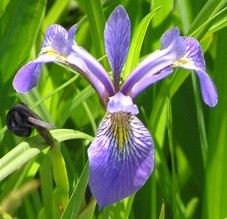 Northern blue flag iris is a clump forming herbaceous perennial native to Eastern North America where it is found in moist to wet habitats including swamps, marshes, stream banks, wet meadows, and ditches. The blue-green sword like leaves may be erect to arching and are up to twenty four inches long and one inch wide. Flowering stems bearing three to five blue to purple flowers each are produced in late spring to summer. Each flower is up to four inches across and consists of three ascending smaller petals and three descending larger petals (actually sepals). The descending petal like sepals are marked by a yellow blotch in the center surrounded by a fan of white markings. Individual flowers are short-lived but a clump of blue flag may be in bloom for about a month. The flowers contain nectar and pollen that attract hummingbirds, bees, and other insects, but the plants are avoided by most mammals. Blue flag does well in 2-4″ of water and is an excellent choice for the wettest zone of a rain garden, but can be grown in moist borders or allowed to naturalize along stream banks or in other wet area. The rhizome is poisonous.
Northern blue flag iris is a clump forming herbaceous perennial native to Eastern North America where it is found in moist to wet habitats including swamps, marshes, stream banks, wet meadows, and ditches. The blue-green sword like leaves may be erect to arching and are up to twenty four inches long and one inch wide. Flowering stems bearing three to five blue to purple flowers each are produced in late spring to summer. Each flower is up to four inches across and consists of three ascending smaller petals and three descending larger petals (actually sepals). The descending petal like sepals are marked by a yellow blotch in the center surrounded by a fan of white markings. Individual flowers are short-lived but a clump of blue flag may be in bloom for about a month. The flowers contain nectar and pollen that attract hummingbirds, bees, and other insects, but the plants are avoided by most mammals. Blue flag does well in 2-4″ of water and is an excellent choice for the wettest zone of a rain garden, but can be grown in moist borders or allowed to naturalize along stream banks or in other wet area. The rhizome is poisonous.
Type: Herbaceous perennial
Bloom: Four to five blue to purple flowers 4″ across are produced on tall stems in late spring to summer.
Size: 24-30″ H x 24-30″ W
Light: Full sun to partial shade
Soil: Fertile, wet to moist, well-drained
Care: Cut back leaves after first frost
Hardiness: Zones 3-9
Pests and Diseases: Aphids, thrips, iris borer, several rots and viruses
Propagation: Division in late summer; seed
Companion Plants: Cardinal flower (Lobelia cardinalis), marsh marigold (Caltha palustris), cinnamon fern (Osmunda cinnamomea).
